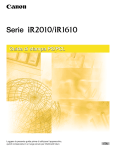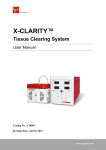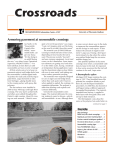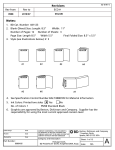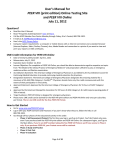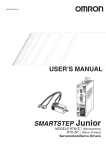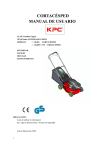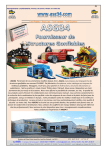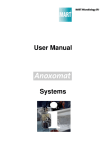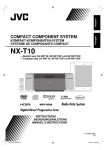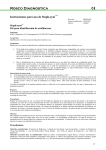Download view pack insert - The Tulip Group, India
Transcript
TM For the Detection, Enumeration and Identification of UTI Pathogens 1. INTENDED USE MICROPROTM BCS (Broth Culture System) is a complete system that detects, enumerates and identifies most pathogens involved in Urinary tract infections, in less than five hours. It consists of (1) Broth Culture System that uses a Turbidimetry-based analyzer for the detection and enumeration of UTI pathogens (2) ID System for Biochemical identification of the UTI organisms. 2. INTRODUCTION Urinary tract infection or UTI, is a major cause of morbidity in humans and one of the most frequently encountered infections that needs to be detected and diagnosed at the very earliest. These infections can occur at different points in the urinary tract, including bladder where it is called cystitis, in the urethraurethritis and in severe cases when infection moves upwards and affects the kidneys, where it is known as pyelonephritis. Symptoms of a lower urinary tract infection can include painful urination and either frequent urination or urge to urinate (or both); while the symptoms of pyelonephritis include fever and flank pain in addition to the symptoms of a lower UTI. About 40% of women and 12% of men have a urinary tract infection at some time in their life. The main causative agent of most UTI's is Escherichia coli, though other bacteria, viruses or fungi may rarely be the cause. Most of the UTI are caused by the eight common urinary pathogens that account for approximately 97% of infections. The primary pathogen involved is Escherichia coli. The fairly common secondary pathogens are Enterococcus faecalis, Klebsiella pneumoniae, Proteus mirabilis, Proteus spp., Pseudomonas aeruginosa. The secondary pathogen which is rarely involved is Citrobacter spp. The common urethral or genital florae include the Lactobacillus, alpha haemolytic streptococci, Gardrerelle vaginalis, Corynebacteria spp. etc. Diagnostic testing of UTI includes urinalysis and urine culture. Urinalysis is a screening test, while the urine culture is considered the gold standard and the only way to make conclusive diagnosis of an UTI. Antibiotic sensitivity can also be performed with these cultures, making them useful in the selection of an appropriate antibiotic for treatment. Conventional diagnostic methods include quantitative culture on solid media, Gram staining of selected colonies and biochemical identification testing. This process can take more than twenty four to forty-eight hours before the microorganisms can be reported to the physicians. 80C 20C REF Store at 0 2-8 C Manufacturer Catalogue Number Consult Instructions for use LOT Batch Number Use by PS Production Site EC REP Authorised Representative A Division of PS Registered Office: Gitanjali, Tulip Block, Dr. Antonio Do Rego Bagh, Alto Santacruz, Bambolim Complex P.O., Goa-403 202, India. E-mail: [email protected] EC Manufacturing Unit: Plot No. S-126, Phase III B, Verna Ind. Estate, Verna, Goa - 403 722, INDIA. REP Qarad b.v.b.a. Cipalstraat 3, B-2440 Geel, Belgium Page 12 of 12 MICROPROTM BCS comprises of a novel way to detect and diagnose UTI by the Turbidimetry-based Bacterial broth culture detection. This system ensures that the entire process of detection and enumeration of UTI organisms is completed in four hours. TM Apart from this a separate MICROPRO ID kit is available for the biochemical identification of UTI pathogens. The Biochemical analysis of UTI organisms can be completed in less than twenty- five minutes. 3. SPECIMEN COLLECTION AND PREPARATION (a). First morning voided, midstream and clean catch urine is recommended for testing. Urine from first morning catheterization or suprapubic taps can also be used. Follow standard recommended procedures for collection of urine specimen. (b). Fresh urine should be used for testing. If a delay in testing is anticipated, store the specimen immediately at 2-8ºC and ensure that the test is performed within 3 hours. (c). It is recommended that sterile containers are used to collect specimen. Contamination of specimen must be avoided. Page 1 of 12 4. SYSTEM CONTENTS S.No. Component Purpose Installation Pack Qty. Cat. No. 1 pack MSIP01 1 unit MA0001 1 MICROPROTM BCS Analyzer Turbidimetry- based analyzer system for + one cable cord and two fuses detection and enumeration of UTI pathogens 2 Blanking Cuvettes (3 ml) Cuvettes for zero blanking the MICROPROTM BCS Analyzer 2 Nos. MABC01 3 Printer Paper Roll Paper Roll for Printing the test results 1 No. MAPR01 4 MICROPROTM ID Well stand Stand for ID Test wells 1 No. MIDS01 5 Fixed Volume Micropipette 100 µL Micropipette for dispensing urine specimen into Barcoded Cuvette (A) & Testing vial (B) 1 No. MAFP01 6 Fixed Volume Micropipette 300 µL Micropipette for dispensing the Broth culture growth into ID Test wells 1 No. MIFP03 7 User Manual Reagent Packs 1 2 3 b) Test Vials (B) - green cap (1.5 ml) Ready to use, Broth culture test vials for ID test only c) 100 µL Microtips Gamma - Sterile microtips with filter barrier for use with 100 µL Fixed volume pipette MICROPROTM- ID kit a) 8 different ID reagents (5 ml) Reagents for biochemical identification of the UTI pathogens b) MICROPROTM ID wells Breakable test wells for use in the Biochemical ID Test Quality Control kit consisting of TM a) MICROPRO UTI Control - Eight different lyophilized UTI Controls red cap (0.5 ml) Media for reconstitution of the lyophilized UTI Controls b) Buffer Media c) 1 mL Micropipette tips Page 2 of 12 Sterile filter barrier microtips for 1 mL Micropipette for the Quality Control test TRT5 TRV5 TR01 COTT25 COTV25 COT001 VAT30 VAV30 VA001 ANTIMICROBIAL AGENT Trimethoprim Trimethoprim / Sulphamethoxazole Vancomycin SYMBOL DISC CONTENT TR 5 mcg COT 1.25 /23.75 mcg VA 30 mcg PACK SIZE 5 Carts 5 Vials Single vial 5 Carts 5 Vials Single vial 5 Carts 5 Vials Single vial TM 1 No. MICROPROTM- Broth Culture kit Ready to use, Barcoded, Broth culture TM a) Barcoded Cuvettes (A) cuvettes for use on MICROPRO BCS black cap (3 ml) Analyser & also for ID Test CAT. NO. 2 x 25 Nos. MBCS01 2 x 25 Nos. 8x1 Nos. MIDR01 12 wells x 25 Nos. 8x1 Nos. Biogram Pack size: 5 Cartridges (Each cartridge contains 50 discs) & Vials (5 vials = 5 x 100 discs in each vial and single vial = 1 x 100 discs in vial). Discs in routine use should be stored at 2-8°C. Longer term storage should be at -20°C. 17. REFERENCES (1). Practical Medical Microbiology, Mackie and MacCartney, Vol 2, 13 th ed, Churchill Livingston 1989, Edited by J,G Collee Duguid, A.G. Fraser, B.P. Marmion. (2). Detection, Prevention and Management of Urinary Tract infections, C.M Kunin, 4th Edition, 1987, (3). McPherson RA, Ben-Ezra J. Basic examination of urine. In: McPherson RA, Pincus MR, eds. (Henry's Clinical Diagnosis and Management by Laboratory Methods.) 22nd ed. Philadelphia, PA: Elsevier Saunders; 2011:chap 28. (4). Hooton TM, Bradley SF, Cardenas DD, et al. Diagnosis, prevention, and treatment of catheter-associated urinary tract infection in adults: 2009 International Clinical Practice Guidelines from the Infectious Diseases Society of America. Clin Infect Dis. 2010; 50(5):625-663. (5). Ban KM, Easter JS. Selected urologic problems. In: Marx JA, Hockberger RS, Walls RM, et al, eds. Rosen's Emergency Medicine: Concepts and Clinical Practice. 7th ed. Philadelphia, Pa: Mosby Elsevier; 2009: chap 97. (6). Dean AJ, Lee DC. Bedside laboratory and microbiologic procedures. In: Roberts JR, Hedges JR, eds. Clinical Procedures in Emergency Medicine. 5th ed. Philadelphia, Pa: Saunders Elsevier; 2009:chap 68. (7). MacFaddin, Jean F. "Biochemical Tests for Identification of Medical Bacteria." Williams & Wilkins, 1980, pp 173 – 183. (8). Bachoon, Dave S., and Wendy A. Dustman. Microbiology Laboratory Manual. Ed. Michael Stranz. Mason, OH: Cengage Learning, 2008. Exercise 15, "Normal Flora of the Intestinal Tract" Print. (9). Bergey's Manual of Systematic Bacteriology, Vol. 1. Baltimore, Williams and Wilkins, 1984. (10). Nicola F1, Centorbi H, Bantar C, Smayevsky J, Bianchini H., Utility of pyrrolidonyl-arylamidase detection for typing Enterobacteriaceae and non-fermenting Gram-negative bacteria, Rev Argent Microbiol. 1995 Oct-Dec;27(4):204-9. (11). Gordon J, McLeod JW. Practical application of the direct oxidase reaction in bacteriology. J Pathol Bacteriol 1928; 31:185-90. (12). Koneman EW, Allen SD, Janda WM, Schreckenberger PC, Winn WC Jr. Color atlas & textbook of diagnostic microbiology. 5th ed. Philadelphia: JB Lippincott, 1997. (13). L Essers and K Radebold, Rapid and reliable identification of Staphylococcus aureus by a latex agglutination test. J Clin Microbiol. Nov 1980; 12(5): 641–643. (14). Kloos, W.E. and P.B. Smith. Staphylococci. 1980. Manual of Clinical Microbiology, 3rd ed. E.H. Lennette, A. Balows, W.J. Hausler, Jr. and J.P. Truant, ed. ASM, Washington, D.C. (15). Finegold, S.M. and E.E. Sweeney. 1961. New Selective and Differential Medium for Coagulase-Positive Staphylococci Allowing Rapid Growth and Stain Differentiation. J. Bacteriol.; 81:636641. (16). Data on file: Microxpress (P) Ltd. MSQC01 1 No. 10 Nos. Page 11 of 12 CAT. NO. FFT200 FFV200 FF0001 GENT10 GENV10 GEN001 IPMT10 IPMV10 IPM001 LET5 LEV5 LE01 LZT30 LZV30 LZ001 MRPT10 MRPV10 MRP001 MZT75 MZV75 MZ001 MXFT5 MXFV5 MXF01 NITT300 NITV300 NIT0001 NXT10 NXV10 NX001 OXT1 OXV1 OX01 PIT100 PIV100 PI0001 PTZT100 PTZV100 PTZ0001 TEIT30 TEIV30 TEI001 TET30 TEV30 TE001 TGCT15 TGCV15 TGC001 TOBT10 TOBV10 TOB001 Page 10 of 12 ANTIMICROBIAL AGENT SYMBOL DISC CONTENT Fosfomycin FF 200 mcg Gentamicin GEN 10 mcg Imipenem IPM 10 mcg Levofloxacin LE 5 mcg Linezolid Meropenem Mezlocillin LZ 30 mcg MRP 10mcg MZ 75mcg Moxifloxacin MXF 5 mcg Nitrofurantoin NIT 300 mcg Norfloxacin NX 10 mcg Oxacillin OX 1mcg Piperacillin PI 100 mcg Piperacillin/Tazobactam PTZ 100/10 mcg Teicoplanin TEI 30 mcg Tetracycline TE 30 mcg Tigecycline TGC 15 mcg Tobramycin TOB 10 mcg PACK SIZE 5 Carts 5 Vials Single vial 5 Carts 5 Vials Single vial 5 Carts 5 Vials Single Vial 5 Carts 5 Vials Single Vial 5 Carts 5 Vials Single Vial 5 Carts 5 Vials Single vial 5 Carts 5 Vials Single vial 5 Carts 5 Vials Single vial 5 Carts 5 Vials Single vial 5 Carts 5 Vials Single vial 5 Carts 5 Vials Single vial 5 Carts 5 Vials Single vial 5 Carts 5 Vials Single vial 5 Carts 5 Vials Single vial 5 Carts 5 Vials Single vial 5 Carts 5 Vials Single vial 5 Carts 5 Vials Single vial 5. TEST PRINCIPLE The entire system is based on three fundamentals: (a). Proprietary broth culture medium to support growth of typical UTI pathogens. (b). Detection and enumeration of UTI based on Turbidimetry. (c). Identification of the UTI pathogen based on well-characterized biochemical tests. Urine Specimen 100 µl (a) 100 µl Step 1: Inoculate same Urine Specimen in Barcoded Cuvette A & Test Vial B Barcoded Cuvette (Broth Medium) A B Test Vial (Broth Medium) Step 2: Measure Initial OD (A0) of Barcoded Cuvette A MICROPRO BCS ANALYZER (b) (for measuring Initial OD-A0 and Final OD-A1 of Barcoded Cuvette A) After Initial OD (A0) Step 3: Incubate Barcoded Cuvette A & Test Vial B for four hours INCUBATOR (35 - 37 0C) Step 4: After incubation, gently swirl the Barcoded Cuvette (A) to homogenize the contents. Measure Final OD (A1) of the Barcoded Cuvette (A) After Final OD (A1) Step 5: If POSITIVE results in Barcoded Cuvette A, Proceed for ID testing of Barcoded Cuvette A & Test Vial B (c) 6. MICROPRO ID TEST A A A B B B Catalase Test VP Test PYR Test Oxidase Test TDA Test Indole Test STORAGE AND STABILITY (a).Store the Barcoded Cuvettes (A)-black cap, Test Vials (B) -green cap and the ID reagents at 2-8 ºC. (b). DO NOT FREEZE. Avoid exposure to light. (c). The shelf life of the Barcoded Cuvettes (A)-black cap, Test Vials (B) -green cap and the ID reagents is as per expiry date mentioned on respective carton/ bottle packaging. 7. MATERIAL REQUIRED BUT NOT PROVIDED WITH THE KIT Bacteriological Incubator (at 35 - 37 °C), Marker Pens, Timer, Tissue Paper, 70% IPA, Bactericidal Handrub, Gloves, Masks and Removable Stickers. Page 3 of 12 8. PRECAUTIONS (a). For laboratory use only. (b). Bring all reagents and specimen to room temperature (20 - 300C) before use. (c). Do not use the kits beyond expiry date.(d).Carefully read the User Manual and package inserts before use. (e).Take Universal Precautions. All human body fluids should be treated as potentially infectious. (f).Always be prepared for any accidental spillage. In case of accidental spillage clean the area thoroughly and wipe with 70% IPA at least three times. (g).It is recommended that basic Personal Protective Equipment like gloves and masks are used at all times. (h).Use a Bactericidal Handrub before and after test procedure. (I). Visually examine the Barcoded Cuvettes (A) with black caps and the Test Vials (B) with green caps to ensure there is no physical damage, microbial contamination, discoloration, precipitation, evaporation or other signs of deterioration. If any of these is observed, do no use these reagents and contact Service provider immediately. (j)The Barcoded Cuvettes (A) and the Test Vials (B) are capped tightly, open carefully to avoid injury due to breakage of glass. (k).Minimize exposure to light. (l).Ensure that the broth culture media (Barcoded Cuvettes (A), the Test Vials (B)) attain room temperature before inoculation and for Biochemical Identification test. 9. CLEANING AND DECONTAMINATION (a). Spills of potentially infectious material should be cleaned up immediately with absorbent paper tissue and the contaminated area should be decontaminated with disinfectants such as 0.5% freshly prepared sodium hypochlorite (10 times dilution of 5% sodium hypochlorite i.e. household bleach) before continuing work. (b). Sodium hypochlorite should not be used on an acid-containing spill unless the spill-area is wiped dry first. Materials used to clean spills, including gloves, should be disposed off as potentially biohazardous waste e.g. in a biohazard waste container. 10. TEST PROCEDURE TM The user is requested to familiarize with the working of the MICROPRO BCS Analyzer before TM embarking on the Test Procedure. (Kindly refer the MICROPRO BCS Analyzer user manual). 1. Detection and Enumeration of the UTI pathogens The detection and enumeration procedure involves the following steps: A). Inoculation of the Barcoded Cuvettes (A) -black cap and the Test Vials (B)- green cap with the patient's urine specimen Note: (a). After inoculation only the Barcoded Cuvettes (A)-black cap, are to be used for testing on the MICROPROTM BCS Analyzer. (b)The Test Vials (B)-green cap along with the Barcoded Cuvettes (A)TM black cap are for Biochemical identification of the UTI organisms using MICROPRO ID kit. 1. Retrieve the required number of Barcoded Cuvettes (A)- black cap and the Test Vials (B)- green cap corresponding to the number of samples to be tested and place it on a stand or a flat clean table top. Kindly note that a single set of Barcoded Cuvette (A)- black cap and the Test Vial (B)- green cap is to be used for one patient. 2. Write patient IDs/names specifically within the space indicated on each set of Barcoded Cuvette (A)- black cap and the Test Vial (B)- green cap. 3. Retrieve the required number of 100 µl micropipette tip pouches from the pack. A pair of microtip is to be used for testing one patient sample. The Individual microtip pouches must be opened just before the inoculation process so as to minimize contamination risk. 4. Open the black cap of the Barcoded Cuvette (A) and the green cap of the Test Vial (B) of one patient and keep aside. Do not remove the yellow coloured rubber stopper. 5. Pipette out 100 µl of well-mixed urine from the sample container and transfer it to the opened Barcoded Cuvette (A) by piercing the pipette microtip through the stopper of the Cuvette and pressing the plunger of micropipette up to the bottom. Do not release the plunger. Holding the rubber stopper tight in its place, slowly remove the microtip, ensuring that the rubber stopper does not come out along with the microtip. Ensure that urine is mixed well with the broth in the Barcoded Cuvette (A) by gently swirling it. Page 4 of 12 TM 16. BIOGRAM Antibiotics Disc as per CLSI standards SYMBOL DISC CONTENT PACK SIZE Amikacin AK 30 mcg 5 Carts 5 Vials Single vial Ampicillin AMP 10 mcg 5 Carts 5 Vials Single vial Amoxicillin/Clavulanate AMC 20/10 mcg 5 Carts 5 Vials Single vial Aztreonam AT 30 mcg Cefazolin CZ 30 mcg Cefepime CPM 30 mcg 5 Carts 5 Vials Single vial Cefotaxime CTX 30 mcg 5 Carts 5 Vials Single vial Cefotaxime/Clavulanic acid (Not as per CLSI) CEC 30/10 mcg 5 Carts 5 Vials Single Vial Cefoxitin CX 30 mcg 5 Carts 5 Vials Single vial Ceftazidime CAZ 30 mcg Ceftazidime/Clavulanic acid (Not as per CLSI) CAC CTRT30 CTRV30 CTR001 Ceftriaxone CTR 30 mcg CXMT30 CXMV30 CXM001 Cefuroxime CXM 30 mcg Ciprofloxacin CIP 5 mcg Clindamycin CD 2 mcg 5 Carts 5 Vials Single vial CLT10 CLV10 CL001 Colistin CL 10 mcg 5 Carts 5 Vials Single vial ETPT10 ETPV10 ETP001 Ertapenem ETP 10 mcg 5 Carts 5 Vials Single Vial CAT. NO. AKT30 AKV30 AK001 AMPT10 AMPV10 AMP001 AMCT30 AMCV30 AMC001 ATT30 ATV30 AT001 CZT30 CZV30 CZ001 CPMT30 CPMV30 CPM001 CTXT30 CTXV30 CTX001 CECT30 CECV30 CEC001 CXT30 CXV30 CX001 CAZT30 CAZV30 CAZ001 CACT30 CACV30 CAC001 CIPT5 CIPV5 CIP01 CDT2 CDV2 CD01 ANTIMICROBIAL AGENT 30/10 mcg 5 Carts 5 Vials Single vial 5 Carts 5 Vials Single vial 5 Carts 5 Vials Single vial 5 Carts 5 Vials Single Vial 5 Carts 5 Vials Single vial 5 Carts 5 Vials Single vial 5 Carts 5 Vials Single vial Page 9 of 12 14. PERFORMANCE DATA Internal Evaluation TM A) In an in-house evaluation, 110 urine specimens were tested simultaneously both on MICROPRO BCS and on standard solid Agar medium. Total Samples = 110 TM MICROPRO BCS PLATE CULTURE Positive for UTI 14 14 Negative for UTI 76 70 Contamination 20 26 From the above evaluation it is observed that TM l For Positive UTI samples: MICROPRO BCS showed 100% correlation with PLATE CULTURE TM l For Negative samples: 76 samples were reported negative by MICROPRO BCS and 70 samples by PLATE CULTURE. TM l Contamination was observed in 20 samples tested by MICROPRO BCS and 26 samples by PLATE CULTURE method. B) Precision: Stability studies were performed on Broth culture media (Barcoded Cuvettes (A) and Test vials (B) for color change, pH, conductivity and OD at 546 nm for three different temperatures 2-8oC, Room temperature and 37oC for a period of 15 days and no variation was observed in color and marginal variation was observed in the other parameters C) Performance: Repeatability and Reproducibility were performed with same sample inoculated in five Barcodes Cuvettes (A) and Initial and Final OD measured. Despite Variation in Initial and Final OD for the same sample inoculated in five cuvettes, the result obtained is same, owing to the delta OD, which diminishes the variation from Cuvette to Cuvette resulting in 100% reproducibility of results. 15. REMARKS (A) False negative results can occur if the contents of the Barcoded Cuvette (A) are not mixed properly prior to measuring the Final absorbance A1 as the culture growth tends to settle down in the Barcoded Cuvette (A)/Test Vial (B) during incubation. To dislodge the cultures settled during incubation, the correct way is to: Hold the cap of the Barcoded Cuvette (A)/ Test Vial (B) and gently swirl it to form a homogeneous suspension. Do not shake vigorously or turn the vial Fig 1 upside down during shaking. ( See Fig 1) (B) Use only the gamma sterile tips provided for the sample pipette (100 µl). Avoid using ETO sterilized tips as, there will be ETO residue left on the tip surface which might get added into the broth during inoculation, leading to growth inhibition. (C) Procedure for dispensing sample in Broth culture cuvettes (A&B): (1) Place your thumb over the top of the pipette plunger and press down to the first stop. Hold the plunger in this position. (2) Place the pipette tip into the sample at the proper immersion depth and release the pressure on the plunger slowly. Be sure that the pipette is either vertical or within 20°off vertical. This will allow the piston to rise, aspirating sample fluid into the pipette tip. Do not remove your thumb from the plunger abruptly or let the plunger rise up quickly. This will result in aspirating incorrect sample volumes.(3) Once the plunger reaches the starting position, pause for a second or two to ensure that the aspiration of the sample fluid is complete. Be sure there are no bubbles in the tip. (4) Remove the pipette tip from the sample volume. (5) To dispense, pierce the cuvette stopper with the pipette tip and then press the plunger down slow and steadily pass the first stop all the way to the bottom of the piston stroke. Wait 1-2 seconds to allow complete dispensing of the sample fluid. Do not release the plunger now. (6) Remove the pipette tip from the Broth culture cuvette and then release the plunger. (7) Press the ejector button to remove the pipette tip or carefully pull the tip off with your fingers and disposed of the tip in the proper biohazard container according to the safety requirements of your facility. Page 8 of 12 Note: For detailed pipetting procedure, refer Section 15 C. 6. Using a fresh microtip, pipette out 100 µl of well mixed urine from same sample container and transfer it to the opened Test Vial (B) by piercing the micropipette tip through the stopper of the Test Vial and pressing the plunger of micropipette up to the bottom. Do not release the plunger. Holding the rubber stopper tight in its place, slowly remove the microtip, ensuring that the rubber stopper does not come out along with the microtip. Ensure that urine is mixed well with the broth in the Test Vial (B) by gently swirling the urine-broth mixture inside the vial. 7. Repeat step 4-6 for all urine samples to be tested. Use fresh microtips each time. 8. The Barcoded Cuvettes (A) and the Test Vials (B) must be recapped with their original black and green cap respectively and placed in the cuvette stand (card board fitment) supplied with the kit. TM B) Blanking the MICROPRO BCS Analyzer Blanking is to be done once a day or when the machine gets switched OFF during the procedure. TM 9. Switch ON the MICROPRO BCS Analyzer. The red power display LED will blink, Press power button followed by the “NEXT” key. The Analyzer will display “Insert Blank and press NEXT or EXIT”. 10. Retrieve one Blanking Cuvette provided with Analyzer. Clean the Blanking Cuvette with the dry tissue. Note: Always make sure to clean the Cuvette with a clean dry tissue paper before blanking or taking OD readings. 11. Insert it in the reading chamber carefully ensuring that the arrow mark on the Blanking Cuvette aligns with the arrow mark next to the reading chamber of the Analyzer and press “NEXT”. 12. After Blanking, enter the lot number details of the Barcoded Cuvette (A) - black cap, in the Analyzer followed by the expiry details which is also mentioned on the Barcoded Cuvette (A) black cap, in the Analyzer and press “NEXT”. 13. The main menu will be displayed, using the scroll down Arrow key, bring the cursor from Lot number to “Initial Absorbance” and press “NEXT” TM C) Measuring Initial Absorbance (Ao) of inoculated Barcoded Cuvette (A)-black cap on the MICROPRO BCS Analyzer 14. Retrieve one Barcoded Cuvette (A) inoculated with patient's urine sample. 15. Insert it carefully in reading chamber as in Step No.11. 16. The initial absorbance (Ao) for the particular Barcoded Cuvette (A) will be displayed on the Analyzer screen. Press “NEXT” key as this will ensure recording of the Initial absorbance (Ao) value in the memory of the Analyzer. Remove the Barcoded Cuvette (A) from the reading chamber and place it in the cuvette stand. 17. Repeat steps (14-16) for rest of the inoculated Barcoded Cuvettes (A).Do not insert Test Vial (B) in the reading chamber. 18. After measuring (Ao) values of all the Barcoded Cuvettes (A), do not switch OFF the Analyzer. 19. Proceed for Incubation of the Barcoded Cuvettes (A) and the Test Vials (B). D) Incubation of the inoculated Barcoded Cuvette (A)-black cap and the Test Vials (B)-green cap 20. Incubate all the inoculated Barcoded Cuvettes (A) and the Test Vials (B) for 4 hours in a Bacteriological Incubator (at 35 - 37 ºC). 21. After 4 Hrs. of incubation, proceed to measure the Final absorbance (A1) values of the Barcoded TM Cuvettes (A) on the MICROPRO BCS Analyzer. E) Measuring Final Absorbance (A1) of the incubated Barcoded Cuvettes (A)-black cap 22. In the display menu of the Analyzer using the scroll down Arrow key, bring the display cursor to “Final Absorbance” in the Main Menu and press “NEXT”. 23. Retrieve one incubated Barcoded Cuvette (A), before inserting it in Analyzer for measuring Final absorbance, kindly note it is imperative to gently swirl the Barcoded Cuvette (A) to disperse Page 5 of 12 culture in the broth. Do not shake the cuvette vigorously as this may result in false negative results. Check Section15 Remarks. After mixing the contents, follow the procedure as in step (11). 24. On valid identification of the Barcoded Cuvette (A), the Analyzer will display the patient name, sample ID, test ID and Final absorbance. Press “NEXT” key as this will ensure recording of the Final absorbance (A1) value in the memory of the Analyzer. Remove the Barcoded Cuvette (A) from the reading chamber and place it in the Cuvette stand. 25. Repeat steps (23-24) for rest of the incubated Barcoded Cuvettes (A). 26. After completing the Final absorbance (A1) for all the incubated Barcoded Cuvettes (A) scroll down in main menu to bring the display cursor to “Results” and press “NEXT”. The results will be displayed Sample Id Wise and the print out can be taken. Details of the “Result” menu management is mentioned in the MICROPROTM BCS Analyzer user manual. F) Result interpretation of Barcoded Cuvettes (A)-black cap There are five types of results expected for the urine samples in MICROPROTM BCS Analyzer, and based on these results further action is recommended. Result reported in S.No. MICROPROTM BCS Analyzer Interpretation of the results 1 Negative Negative for UTI 2 103 < 105 CFU/ml Threshold or Evolving UTI infection 3 105 < 107 CFU/ml Positive (Frank UTI) 4 107 < 108 CFU/ml Further Action No further action required. Report with printout of result. Proceed for Biochemical identification testing as recommended in Biochemical ID Kit packinsert. Proceed for Biochemical identification testing as recommended in Biochemical ID Kit packinsert. Positive (Frank UTI with High Count) Proceed for Biochemical identification 5 > 108 CFU/ml Very High Count. testing as recommended in Mixed infection possible. Biochemical ID Kit packinsert. Negative Test results: · The Barcoded Cuvettes (A) with Negative results along with its Test Vials (B) are to be discarded as per local disposal guidelines, and sample to be reported negative with printout of the result. Page 6 of 12 Positive Test results: · The Barcoded Cuvette (A) with Positive results along with the corresponding Test Vial (B) are to be retained TM in the Cuvette stand and then proceed for Biochemical identification testing using MICROPRO ID Kit. Note (a) ODs displayed on the instrument screen are for indicative purpose only. 11. BIOCHEMICAL IDENTIFICATION OF UTI PATHOGENS TM The MICROPRO ID test helps in identifying the eight possible UTI pathogens namely E. coli, Enterococcus faecalis, Streptococcus pyogenes, Proteus mirabilis, Proteus spp., Pseudomonas TM aeruginosa, Citrobacter spp., Klebsiella pneumoniae. For the Test procedure refer the MICROPRO IDkit Pack insert. 12. ANTIBIOTIC SUSCEPTIBILITY TEST After the completion of Biochemical Identification tests, proceed for Antibiotic Susceptibility Test in four steps as follows: TM Step 1) After completing Biochemical Identification tests about 1 ml of broth will remain in MICROPRO Barcoded Cuvette (A). Centrifuge the cuvettes at RCF of 5000 g for 10 minutes at room temp. A visible pellet will be observed. Discard the supernatant carefully by inverting the cuvette and retain the pellet. With a sterile loop, touch the pellet and transfer it to the tube of saline/peptone water. Dissolve the inoculum thoroughly to avoid clumping of the cells. Adjust turbidity of inoculum to match the standard, i.e., McFarland 0.5 equals approximately 10*8 CFU/mL. Step 2) Proceed for inoculation on Mueller-Hinton Agar plate. Visually examine the Mueller Hinton Agar plates prior to use, ensure that the plates are: free from visible contamination, poured to a uniform depth of approximately 4mm, not excessively wet and not cracked or dry. Sterile Ready Prepared ® Mueller- Hinton Agar Plates (Cat no. SP0012011) is available with MICROXPRESS . Within 15 minutes of preparing the adjusted inoculum, dip a sterile cotton swab (Steristik, Cat no. AC0003) into the inoculum. Rotate the swab several times and press firmly on the inside wall of the tube above the fluid level to remove excess inoculum from the swab. Streak the swab over the entire surface of the Mueller Hinton agar plate. Rotate the plate approximately 60° then repeat streaking motion. Rotate 60° again and repeat streaking for the third time. Complete inoculation by running the swab around the rim of the agar. Step 3) Dispense the required number of antibiotic disks to the agar surface with a sterile forcep or disc dispenser (forceps can be sterilized by flaming with alcohol. Avoid using over-heated forceps). Do not relocate any antibiotic disk after contact with the agar. After application, ensure that the antibiotic disk has made complete contact with the agar surface by touching the top of the disk with TM forceps. Antibiotic discs (Biogram ) recommended for UTI pathogens (as per CLSI) are available ® with MICROXPRESS . (Refer antibiotics list mentioned in Section 16 ). Step 4) Keep the plates in the incubator set at 35-37° C for overnight and then look for zone of inhibition as TM per CLSI guidelines. Refer Biogram Packinsert for detailed AST analysis. 13. QUALITY CONTROL PROCEDURES TM TM Quality control of MICROPRO BCS system can be performed with MICROPRO UTI Control kit which is available separately (Cat No MSQC01). Quality control is to be performed for each batch to ensure that (1) Barcoded Cuvettes (A), Test Vials (B), the MICROPROTM ID Kit reagents and the MICROPROTM BCS Analyzer are working as per specifications. For TM the Test procedure refer the MICROPRO UTI Control Kit pack insert. Page 7 of 12







